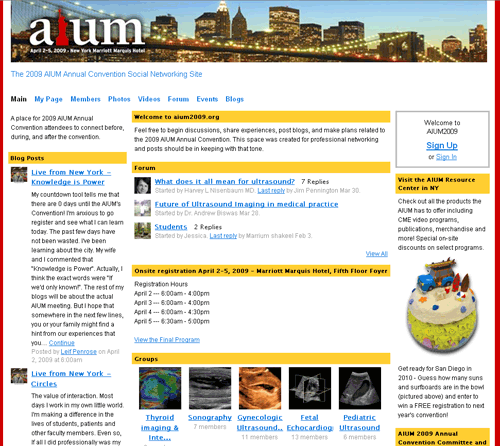AIUM preview: Sonologists bring annual convention to Facebook
The American Institute of Ultrasound in Medicine has launched a social networking site to allow attendees to hook up, discuss, and even blog before, during, and after the group’s 2009 meeting in New York City starting April 2. At least a dozen ultrasound subspecialties are now linked through the site, as well as through Facebook and Twitter.
The American Institute of Ultrasound in Medicine has launched a social networking site to allow attendees to hook up, discuss, and even blog before, during, and after the group's 2009 meeting in New York City starting April 2. At least a dozen ultrasound subspecialties are now linked through the site, as well as through Facebook and Twitter.
AIUM members deem their clinical practice communities, such as cardiac and musculoskeletal sonography, as valuable interactive platforms. But participation in "Community of Practice" meetings with subspecialty experts had always been limited to the society's annual convention.
Starting last October, however, AIUM members, convention attendees, and even those who cannot attend the meeting have been allowed to participate online at any time through aium2009.org, said Jennifer Hilderbrand, AIUM director of membership and marketing and creator of the social networking site.

"One of the unique characteristics of AIUM is that we have the ability to bring together every specialty interested in ultrasound," Hilderbrand told
Diagnostic Imaging.
"Aium2009.org exponentially expands the opportunity for (sonologists) to connect."
Site content is open to anyone.
Members can establish one-on-one links through aium2009.org. The site was developed specifically for this year's convention to gauge the interest in social networking among members. The response has been overwhelming, with more than 8000 people from about 123 countries visiting the site so far, Hilderbrand said.
Site visitor demographics published recently in
Sound Waves,
the society's monthly newsletter, show the following trends:
• More than half of people who have joined the site are AIUM members
• Visitor age ranges from 20 to 60-plus
• 65% live in the U.S.
• 33% are physicians, 44% sonographers, and 23% scientists or "other"
More than 150 individuals have already created personal profiles, joined groups, and started discussion on some of the annual meeting's highlights. Hot topics include the need to make the Focused Assessment with Sonography for Trauma (FAST) a standard procedure for some critically ill patients, the role of intraoperative ultrasound in brain surgery, and detection of thyroid follicular cancer.
The society plans to keep aium2009.org live for at least two months after the convention to let people exchange and retrieve meeting-related information, Hilderbrand said. The AIUM has also created
and
accounts to connect the larger ultrasound community. The society is considering moving content from aium2009.org over to a larger AIUM social networking site in Facebook.
The main site, AIUM.org, will remain the society's core business platform. Members still need to go there to register for courses, access guidelines, and take care of membership needs, Hilderbrand said. People nowadays spend a lot of time on social networking sites. The society thus hopes to redirect flow from general discussions generated at aium2009.org toward the specific clinical, scientific, and regulatory information stored in the society's official website.
"By having that connection we are bringing the AIUM to them. When they want more information on things they see on the social networking site, they can go back to the AIUM home site and access more information," Hilderbrand said.
For more information from the Diagnostic Imaging and SearchMedica archives:
Contrast ultrasound could reduce unneeded prostate biopsies
Emergence of elastography gives renewed impetus and vigor to ultrasound market
Sonologists produce sweeping agreement on ultrasound bioeffects
FDA warning stalls AIUM-supported ultrasound contrast trial
AIUM toughens policy on keepsake ultrasound
What New Research Reveals About Novice Use of AI-Guided Cardiac Ultrasound
April 4th 2025In a study recently presented at the American College of Cardiology (ACC) conference, researchers found that novice use of AI-guided cardiac ultrasound after an AI-enabled electrocardiogram increased the positive predictive value for reduced left ventricular ejection fraction (LVEF) or aortic valve stenosis by 33 percent.
The Reading Room: Racial and Ethnic Minorities, Cancer Screenings, and COVID-19
November 3rd 2020In this podcast episode, Dr. Shalom Kalnicki, from Montefiore and Albert Einstein College of Medicine, discusses the disparities minority patients face with cancer screenings and what can be done to increase access during the pandemic.
New AI-Enabled Portable Ultrasound May Facilitate 50 Percent Reduction in Cardiac Imaging Scan Time
March 28th 2025Artificial intelligence (AI)-powered measurement capabilities provide key features with the Compact Ultrasound 5500CV device, which was unveiled at the American College of Cardiology (ACC) conference.